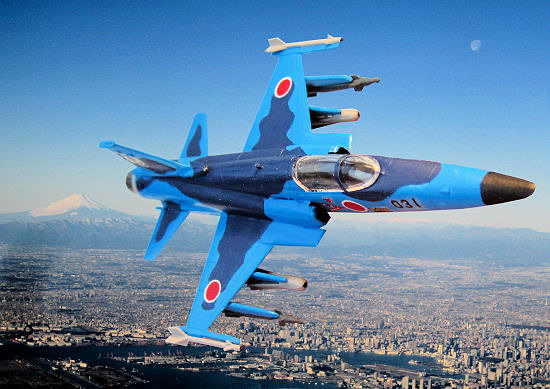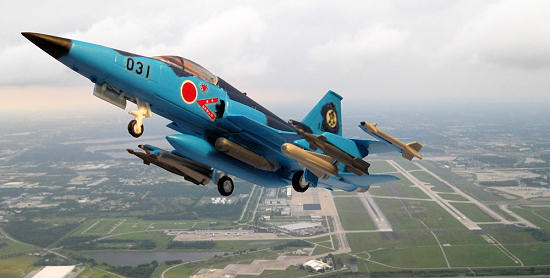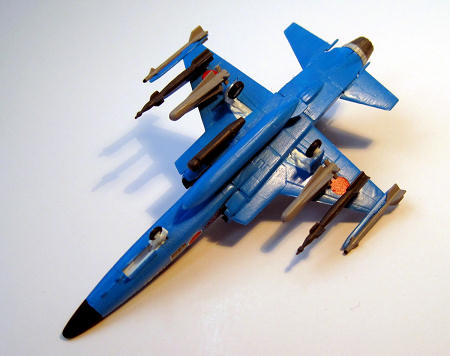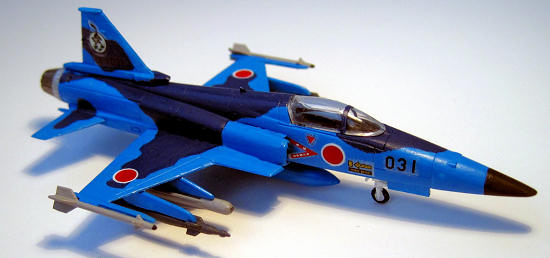LS 1/144 F-20 Tigershark
|
KIT #: |
? |
|
PRICE: |
$1.20 at Xinshi, Beijing
|
|
DECALS: |
One option |
|
REVIEWER: |
Richard F |
|
NOTES: |
|

(Alternative) History:
Northrop had a great plane on its hands in the early 80s but it just
couldn't sell one. By pimping out its popular basic model, the F-5E, the
storied American company had created a really hot ship - the Tigershark.
With 60 per cent more power than the F-5, the Tigershark could blast along
at Mach 2, and with an advanced radar it had beyond visual range capability
and could fire guided air-to-ground missiles. But why wouldn't anyone buy
one?
The company was hemorrhaging cash on this project. Some in the boardroom
blamed the Air Force "Fighter Mafia" for pushing the F-16 (even though it
wasn't as good). Others looked internally. Maybe the sales pitch wasn't
right. Maybe there was a market for the Tigershark after all.
The company's best pitch team rolled into action.
Looking for smaller air forces with cash and a capability gap, they found
willing listeners in Bahrain and South Korea. Some tentative orders there
were promising, but not
 enough to justify production. Then they visited
Tokyo. They didn't know it at the first meeting, but this time they'd saved
the project (and saved their jobs!)
enough to justify production. Then they visited
Tokyo. They didn't know it at the first meeting, but this time they'd saved
the project (and saved their jobs!)
Japan really needed to upgrade its fleet. It had some brand new F-15s
patrolling its skies but the rest of its fleet was old. Phantoms.
Starfighters. Even Sabres, in the recon role. It was time for a highly
capable new "Support Fighter". The F-16 people were lobbying hard. Very
hard. Maybe even ever-so-slightly-ungentlemanly hard. In Japan, there was a
strong faction pushing to develop a new fighter at home.
And so Northrop found its opening. Buy the F-20 and build it in Japan.
Developed privately, the F-20 wasn't so tied to the specific requirements of
the USAF. Yet most of its development costs had been covered, so Japan would
save hundreds of millions yet still be able to tweak the design.
The deal was signed. A great deal of sake was consumed. Big bonuses were
paid. And the JASDF got 200 highly capable new support fighters.
Entering service in the late 80s, the F-20J Tigershark still serves
alongside F-15Js on Japanese airbases. It has been progressively updated
just like its nemesis the F-16. Today, upgraded to the F-20J kai standard,
it can carry the AMRAAM missile, and with the addition of a
Japanese-designed laser designation system on a small pylon under the
leftside intake, it can deploy precision guided bombs day or night (after
jettisoning the centerline tank). With its digital recon pod, it can conduct
tactical recon missions and beam the imagery back in real time via
satellite. It provides significant tactical capability across a range of
roles and is the perfect complement to the JASDF F-15Js.
For years, the USAF refused to let the JASDF fly F-20s against its F-16s in
mock combat. Finally, in 2002, in the aptly-named Keen Shark joint exercise,
the F-16s and F-20s squared off over the training range. In BVR, the F-16s
had better luck, with their greater load of AMRAAM missiles. But close in,
the dogfighting was so tightly fought that even the most virulent Viperista
had to admit that the Tigershark was a hot ship.
[obviously most of that is made up. Oh, and before the Viper Fan Boyz e-mail
me: dude, it's just a story!]
 This is a very neat little 1/144 kit. At 8 RMB in Beijing it was very
attractively priced. I have seen it online at a major US model seller for
over 15 dollars which is pretty outrageous. If I'd known that, I would have
picked up the other 5 kits at the shop!
This is a very neat little 1/144 kit. At 8 RMB in Beijing it was very
attractively priced. I have seen it online at a major US model seller for
over 15 dollars which is pretty outrageous. If I'd known that, I would have
picked up the other 5 kits at the shop!
Moulded in white plastic with nicely engraved panel lines, this really is
a gem.
The shape seems just right. There is no cockpit detail. The kit includes a
centerline fuel tank, a big centerline recon pod, two passable AGM-65
Mavericks and two squashed-looking Snake-eye bombs. The two nice Sidewinders
wrap up the stores and allow you to tool this Tigershark up for some serious
business.
Decals seem usable after all this time. They allow you to do the
generic-looking F-20 prototype in grey.
I painted the cockpit area black and added a bit of
nose weight before gluing the fuselage together. It fits nicely and there
wasn't much call for filling or sanding. A little underneath the tail and
around the area where the intakes connect to the main part of the plane was
all that I did.
The wing pylons fit perfectly and so did the belly tank. I dry fitted the
recon pod which also looked pretty cool.
 After painting - see below - I went back and added the nicely done
undercarriage. It comes with fairly thin wheel bay doors.
After painting - see below - I went back and added the nicely done
undercarriage. It comes with fairly thin wheel bay doors.
Add the underwing stores and you're done.
For my fictional F-20J kai, I used the kit's weapons except for the bombs. I
replaced them with some laser guided bombs from a Dragon kit. Then I used
some scrap plastic to add a little pylon under the left side intake, which
would hold a designation pod. Looks like the pilot would need to jettison
the fuel tank in order for this pod to have a full view of the target area.
I took another bomb from another 1/144 kit, chopped off the fins, and carved
the front a bit to make what was meant to look like the moving ball thing at
the front of these pods, the part containing the laser and TV camera for the
pod to stay aimed at the target even as the aircraft changes position.
I have no idea whatsoever whether that arrangement is plausible or practical
but it's a "what-if", not a museum piece.
This is the part I enjoyed the most. The real F-20 prototype was a boring
grey. Great for low visibility in air combat I guess, but pretty lame to
look at. So I thought for a while about what alternative schemes I could do.
I wanted to make something historically plausible, so, for example, a Royal
Air Force version didn't seem likely to me. I thought either an air force
that had used the F-5 and
 might have upgraded, or an air force that bought
the F-16 or Mirage 2000 around the mid to late 80s. Then I was limited by
the decals I had in my spares department. It isn't every day I build a 1/144
kit, and it isn't every kit that comes with a spare set of decals.
might have upgraded, or an air force that bought
the F-16 or Mirage 2000 around the mid to late 80s. Then I was limited by
the decals I had in my spares department. It isn't every day I build a 1/144
kit, and it isn't every kit that comes with a spare set of decals.
I settled on Japan when I discovered a bunch of red circles left over from
the equally-neat LS Mitsubishi F-1 kit. At that point I thought I would do a
F-4EJ kai style scheme of light blue over gull grey. But as I looked into a
potential backstory a bit more, I learned of the Mitsubishi F-2, which is
Japan's extremely expensive souped-up F-16 that came into service in the
1990s after a costly, controversial and protracted development.
It has an awesome colour scheme of light, bright blue with splotches of a
rich middle blue.
I could not find reference to exact paint colours for this scheme, so I used
Tamiya XF-8 Flat Blue (acrylic) for the darker blue areas. For the lighter
overall blue, I mixed a small amount of Mr Color 65 Bright Blue (enamel)
into a large amount of Mr Color 34 Sky Blue. It needed something else,
because what I ended up with is not quite the right colour, but I couldn't
work out what else to mix in so after various experiments I went with this.
Decals were basically imagined but drew on a few photos. The tail art
actually comes from a Tamiya 1/100 Fiat G-91 kit, but it seemed fine for
this "what-if".
I don't know that I'd pay 15 bucks for this kit but if you can find it at a
reasonable price, it's excellent (especially considering its age). The F-20
offers a wealth of possibilities for what-if builds when you consider the
number of air forces that operated the F-5 (for which it might have been a
logical upgrade) and/or the F-16 (against which it was a direct competitor).
 http://en.wikipedia.org/wiki/F-20_Tigershark
http://en.wikipedia.org/wiki/F-20_Tigershark
http://en.wikipedia.org/wiki/Mitsubishi_F-2
and google.
Richard F
October 2011
If you would like your product reviewed fairly and fairly quickly, please contact the editor or see other details in the Note to
Contributors.
Back to the Main Page
Back to the Review
Index Page


 enough to justify production. Then they visited
Tokyo. They didn't know it at the first meeting, but this time they'd saved
the project (and saved their jobs!)
enough to justify production. Then they visited
Tokyo. They didn't know it at the first meeting, but this time they'd saved
the project (and saved their jobs!) This is a very neat little 1/144 kit. At 8 RMB in Beijing it was very
attractively priced. I have seen it online at a major US model seller for
over 15 dollars which is pretty outrageous. If I'd known that, I would have
picked up the other 5 kits at the shop!
This is a very neat little 1/144 kit. At 8 RMB in Beijing it was very
attractively priced. I have seen it online at a major US model seller for
over 15 dollars which is pretty outrageous. If I'd known that, I would have
picked up the other 5 kits at the shop! After painting - see below - I went back and added the nicely done
undercarriage. It comes with fairly thin wheel bay doors.
After painting - see below - I went back and added the nicely done
undercarriage. It comes with fairly thin wheel bay doors. might have upgraded, or an air force that bought
the F-16 or Mirage 2000 around the mid to late 80s. Then I was limited by
the decals I had in my spares department. It isn't every day I build a 1/144
kit, and it isn't every kit that comes with a spare set of decals.
might have upgraded, or an air force that bought
the F-16 or Mirage 2000 around the mid to late 80s. Then I was limited by
the decals I had in my spares department. It isn't every day I build a 1/144
kit, and it isn't every kit that comes with a spare set of decals.  http://en.wikipedia.org/wiki/F-20_Tigershark
http://en.wikipedia.org/wiki/F-20_Tigershark